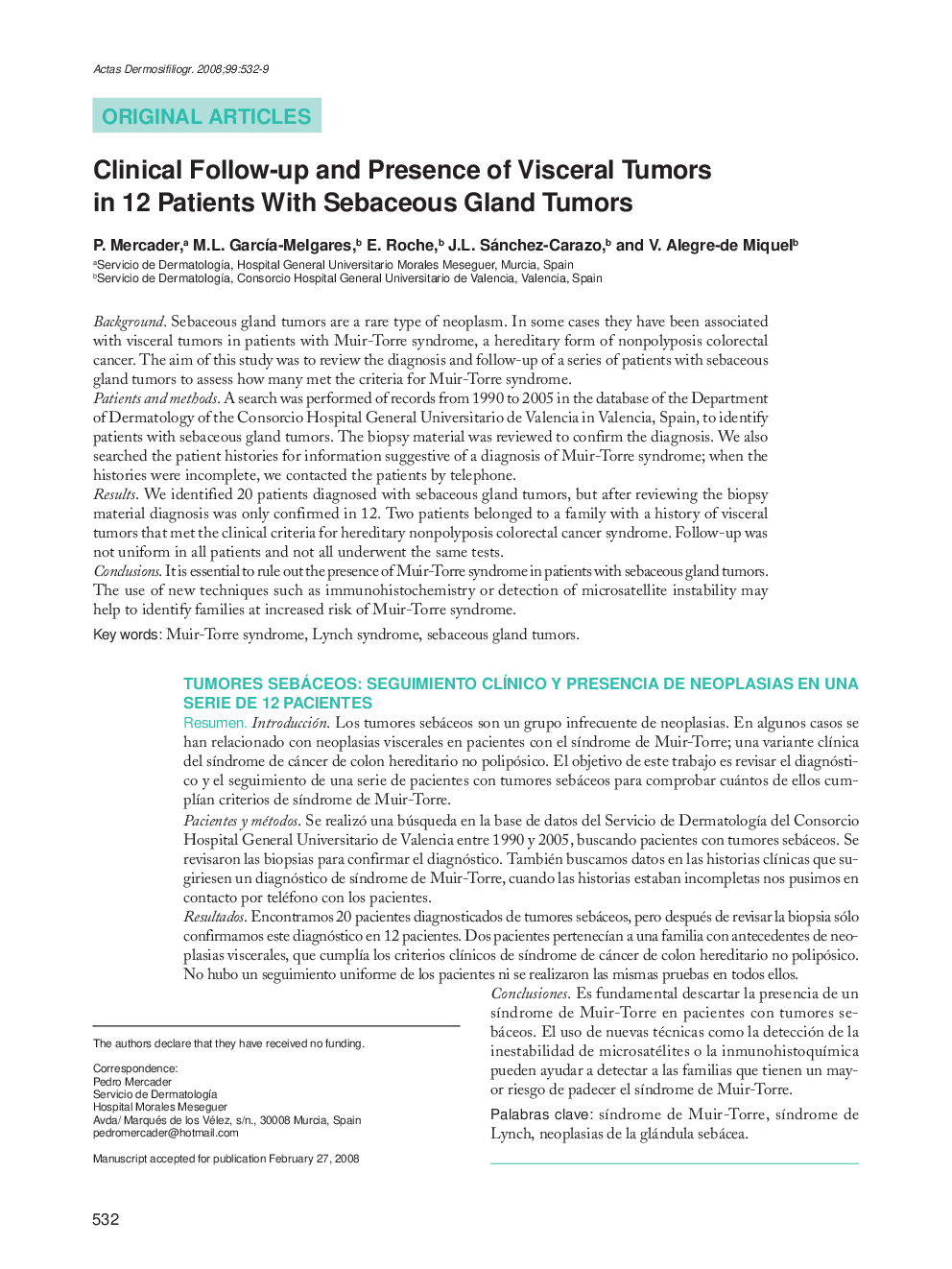| کد مقاله | کد نشریه | سال انتشار | مقاله انگلیسی | نسخه تمام متن |
|---|---|---|---|---|
| 3183764 | 1200716 | 2008 | 8 صفحه PDF | دانلود رایگان |

BackgroundSebaceous gland tumors are a rare type of neoplasm. In some cases they have been associated with visceral tumors in patients with Muir-Torre syndrome, a hereditary form of nonpolyposis colorectal cancer. The aim of this study was to review the diagnosis and follow-up of a series of patients with sebaceous gland tumors to assess how many met the criteria for Muir-Torre syndrome.Patients and methodsA search was performed of records from 1990 to 2005 in the database of the Department of Dermatology of the Consorcio Hospital General Universitario de Valencia in Valencia, Spain, to identify patients with sebaceous gland tumors. The biopsy material was reviewed to confirm the diagnosis. We also searched the patient histories for information suggestive of a diagnosis of Muir-Torre syndrome; when the histories were incomplete, we contacted the patients by telephone.ResultsWe identified 20 patients diagnosed with sebaceous gland tumors, but after reviewing the biopsy material diagnosis was only confirmed in 12. Two patients belonged to a family with a history of visceral tumors that met the clinical criteria for hereditary nonpolyposis colorectal cancer syndrome. Follow-up was not uniform in all patients and not all underwent the same tests.ConclusionsIt is essential to rule out the presence of Muir-Torre syndrome in patients with sebaceous gland tumors. The use of new techniques such as immunohistochemistry or detection of microsatellite instability may help to identify families at increased risk of Muir-Torre syndrome.
ResumenIntroducciónLos tumores sebáceos son un grupo infrecuente de neoplasias. En algunos casos se han relacionado con neoplasias viscerales en pacientes con el síndrome de Muir-Torre; una variante clínica del síndrome de cáncer de colon hereditario no polipósico. El objetivo de este trabajo es revisar el diagnóstico y el seguimiento de una serie de pacientes con tumores sebáceos para comprobar cuántos de ellos cumplían criterios de síndrome de Muir-Torre.Pacientes y métodosSe realizó una búsqueda en la base de datos del Servicio de Dermatología del Consorcio Hospital General Universitario de Valencia entre 1990 y 2005, buscando pacientes con tumores sebáceos. Se revisaron las biopsias para confirmar el diagnóstico. También buscamos datos en las historias clínicas que sugiriesen un diagnóstico de síndrome de Muir-Torre, cuando las historias estaban incompletas nos pusimos en contacto por teléfono con los pacientes.ResultadosEncontramos 20 pacientes diagnosticados de tumores sebáceos, pero después de revisar la biopsia sólo confirmamos este diagnóstico en 12 pacientes. Dos pacientes pertenecían a una familia con antecedentes de neoplasias viscerales, que cumplía los criterios clínicos de síndrome de cáncer de colon hereditario no polipósico. No hubo un seguimiento uniforme de los pacientes ni se realizaron las mismas pruebas en todos ellos.ConclusionesEs fundamental descartar la presencia de un síndrome de Muir-Torre en pacientes con tumores sebáceos. El uso de nuevas técnicas como la detección de la inestabilidad de microsatélites o la inmunohistoquímica pueden ayudar a detectar a las familias que tienen un mayor riesgo de padecer el síndrome de Muir-Torre.
Journal: Actas Dermo-Sifiliográficas (English Edition) - Volume 99, Issue 7, 2008, Pages 532-539